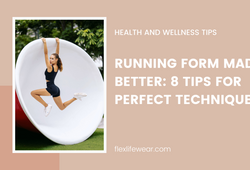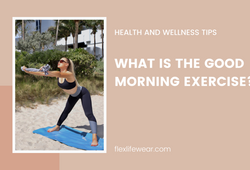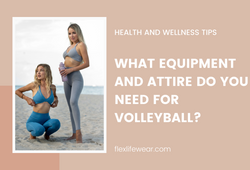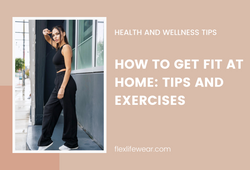When you exercise, the clothing you wear can make a big difference in how comfortable and successful your workout is. While style and fit matter, the fabric of your gym clothes is key. The right material can improve your performance, keep you comfortable, and regulate your body temperature during different exercises.
When it comes to exercising, the clothes, like t-shirts, sports bras or leggings you wear can make a big difference in how good your workout feels. While style and fit matter, the type of fabric your gym clothes are made of is really important. The right material can improve your performance, keep you comfortable, and regulate your body temperature during different activities.
In this guide, we will explore different types of materials suitable for gym wear, discuss their benefits and drawbacks, and help you understand why choosing wisely can be the difference between a good and a great workout. By the end of this article, you'll be equipped with the knowledge to select gym apparel that not only looks good but also enhances your performance and comfort.

Types of Materials Commonly Used for Gym T-Shirts
When you're shopping for a gym t-shirt, the type of fabric you choose can really make a difference in how comfortable and effective it is. Let's take a look at some of the most popular materials used in gym clothing, and the pros and cons of each:
1. Cotton
Cotton is a natural fiber that is prized for its softness, comfort, and breathability. It feels gentle against the skin, making it a popular choice for everyday wear, including gym t-shirts. Cotton's natural fibers allow air to circulate and heat to escape, thereby keeping the wearer cool during less intense workouts. Cotton is ideal for low-intensity workouts, yoga sessions, or leisure activities where comfort is paramount and excessive sweating is not an issue.
Pros:
- Cotton is renowned for its softness and comfort.
- It is highly breathable, which helps to keep the body cool.
- Hypoallergenic, making it suitable for sensitive skin.
Cons:
- Cotton absorbs moisture, which can make it heavy and wet during workouts.
- It dries slowly, which can be uncomfortable in a gym setting and cause chafing.
- Not the most durable option for intense workouts.
2. Polyester
Polyester is a synthetic fabric known for its durability, resistance to wrinkling, and quick-drying properties. It efficiently wicks moisture away from the skin, facilitating rapid evaporation and helping to keep the wearer dry and comfortable during intense physical activities. Polyester is also highly resistant to shrinking and maintains its shape well over time.
It’s ideal for high-intensity workouts like running, cycling, or any activity that involves a lot of sweating, as it helps in moisture management.
Pros:
- Polyester is lightweight and highly durable.
- It wicks moisture away from the body, helping to keep the wearer dry.
- It is resistant to wrinkles and shrinking.
Cons:
- Polyester is less breathable compared to natural fabrics.
- It can retain odors if not treated with antimicrobial agents.
- Some find it less comfortable on the skin due to its synthetic nature.
3. Nylon
Nylon is another synthetic fabric, valued for its exceptional strength and elasticity. It's smooth, lightweight, and dries quickly, making it a comfortable choice for active wear. Nylon also has excellent moisture-wicking properties and is resistant to abrasion, which makes it durable for rigorous physical activities. Nylon is ideal for activities that require a great deal of movement and flexibility, such as aerobics and martial arts, due to its stretchy nature and durability.
Pros:
- Nylon is exceptionally strong and stretchy.
- It dries quickly and is highly moisture-wicking.
- Resistant to mold and mildew.
Cons:
- It can sometimes feel less natural and not as breathable as cotton.
- Like polyester, untreated nylon may retain odors.
4. Spandex
Spandex is a synthetic fiber known for its remarkable ability to stretch—up to five times its original length—and its ability to return to its original shape. This makes it ideal for sports apparel where a close, comfortable fit is necessary. It is often blended with other materials to provide added stretch and mobility.
Spandex is ideal for any workout requiring freedom of movement, including yoga, pilates, and strength training, where flexibility of the garment is essential.
Pros:
- Spandex is celebrated for its exceptional elasticity.
- It enhances the range of motion and offers an excellent fit.
- Holds shape well, even after repeated stretching and washing.
Cons:
- Often used more as a blend with other materials since alone it may be too stretchy.
- Can hold body heat, which might lead to discomfort during intense exercises.

Benefits of Blended Fabrics
Blended fabrics are created by combining two or more different types of fibers to capitalize on the beneficial properties of each while minimizing their individual weaknesses. In the context of gym wear, such as t-shirts, using blended fabrics can offer several advantages:
- Enhanced Durability
Blending fibers can significantly increase the strength and longevity of a fabric. For example, adding polyester to cotton increases the overall durability of the material, making it more resistant to wear and tear. This is particularly beneficial for gym wear, which often undergoes frequent washing and exposure to rigorous physical activity.
- Improved Moisture-wicking
Blended fabrics can optimize moisture-wicking properties, which are crucial for workout apparel. For instance, a blend of cotton and polyester can help in managing sweat better than pure cotton. The polyester helps to wick moisture away from the skin to the outer surface of the fabric, where it can evaporate more quickly, while the cotton component adds a touch of breathable comfort.
- Enhanced Comfort and Fit
Blends can offer a better fit and increased comfort. The addition of elastane (Spandex) to materials like cotton or polyester provides stretchability, which allows the fabric to conform to the body's movements more fluidly and comfortably. This stretch also helps maintain the shape of the garment, even after stretching and repeated washes.
- Versatility in Textures and Weights
Fabric blends allow for a greater variety of textures and fabric weights, making them suitable for different types of weather and workout conditions. For example, lighter blends are perfect for high-intensity workouts or warmer climates, while heavier blends might be ideal for outdoor activities in cooler temperatures.
- Cost-Effectiveness
Blended fabrics can be more cost-effective than 100% natural fibers. Synthetics like polyester are generally less expensive than natural fibers like cotton or wool, so blending them can reduce costs while still providing many of the desirable properties of the natural fibers.
- Reduced Wrinkling and Easier Care
Blends often require less care than pure fabrics. For instance, polyester-cotton blends are less likely to wrinkle than pure cotton and dry much faster, making them more convenient for users who need low-maintenance clothing for the gym.
- Aesthetic Variety
Blending different fibers can produce a variety of colors and patterns not achievable with single fiber fabrics. This variety can make gym apparel more attractive and stylish, appealing to a broader range of tastes and preferences.
Blended fabrics in gym wear offer a practical and effective way to enhance athletic performance and comfort. They combine the best features of their component materials, providing durability, moisture management, and comfort, while also being cost-effective and easy to maintain. This makes them an excellent choice for anyone looking for reliable and functional workout apparel.
Additionally, for other gym clothes as well, like sports bras and leggings, blended fabrics are particularly beneficial as they combine flexibility with support. Tops and leggings often require materials that can stretch without losing form, supporting dynamic movements while offering compression where needed. The elastic nature of blends like polyester-spandex or nylon-spandex provides excellent compression for muscle support in leggings, while ensuring the tops maintain their shape and provide adequate coverage without sagging. This makes blended fabrics an excellent choice for both aesthetics and functionality in versatile workout wardrobes, ensuring that athletes not only look good but also feel supported during their fitness routines.
What materials to avoid?
When choosing materials for gym wear, certain fabrics might not offer the best performance or comfort during workouts. Here are some materials you might want to avoid and why:
- 100% Cotton
While cotton is breathable and soft, it's not ideal for intense workouts because it absorbs moisture and retains it. This can lead to a heavy, damp feeling and can also cause chafing and irritation when wet. Additionally, wet cotton can lose its shape and become saggy.
- Heavy Fabrics
Materials that are inherently heavy, such as thick fleece or wool blends, are not suitable for gym wear. They can restrict movement and lead to overheating during exercise.
- Non-Breathable Plastics and Rubber-Based Materials
Some cheaper synthetic materials, often used in fashion sportswear, may not be breathable. Materials like PVC or cheap neoprene can trap heat and moisture against the skin, causing discomfort and excessive sweating.
- Rough Textures
Fabrics with a rough texture can irritate the skin, especially during repetitive movements. Materials that are coarse or have large, stiff weaves are less likely to provide the comfort needed for effective workouts.

Top Recommendations for Gym T-Shirts and Where to Buy
When looking for high-quality gym t-shirts that meet a range of needs from moisture management to style and comfort, one great place to start is FlexLifeWear.
Crafted entirely from high-quality polyester, nylon, spandex and cotton, these t-shirts are lightweight and durable, perfect for everyday gym sessions. The fabrics blend is breathable and designed to wick sweat away rapidly, which helps in keeping odors at bay.
By choosing FlexLifeWear, you can choose a gym t-shirt material that not only suits your workout needs but also contributes to a more comfortable, efficient, and enjoyable fitness routine.
FAQ
Does polyester make you sweat?
Polyester doesn't directly cause you to sweat, but it can trap heat and moisture due to its less breathable nature, potentially leading to more sweating during intense activities. A solution to this issue is wearing a blend of materials that combines polyester's durability and moisture-wicking properties with the breathability of other fibers like cotton.
Does viscose make you sweat?
Viscose itself doesn't cause sweating, but it does absorb moisture rather than wicking it away, which can make you feel damp and clammy when you sweat. Unlike materials specifically designed for exercise that wick moisture away from the skin and dry quickly, viscose can hold onto moisture, potentially increasing discomfort during physical activities.
What’s the meaning of synthetic dry?
Materials such as polyester, nylon and acrylic were designed with the features of quick drying and moisture absorption. When people say that these clothes are ‘synthetic dry’ it means that they do not retain much moisture and can dry very quickly compared to natural fibers like cotton, which absorbs and retains moisture for longer periods.
Is cotton or polyester better?
The choice between cotton and polyester depends on your needs: Cotton is better for everyday comfort and breathability, making it ideal for casual wear and mild weather. Polyester excels in durability, moisture-wicking, and quick-drying properties, which are preferable for sportswear and active use.


























